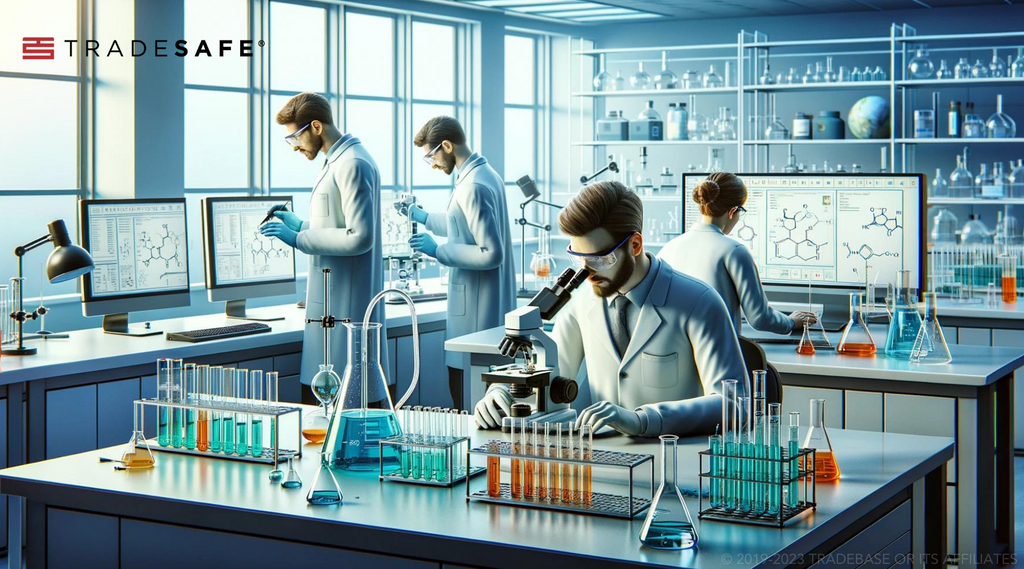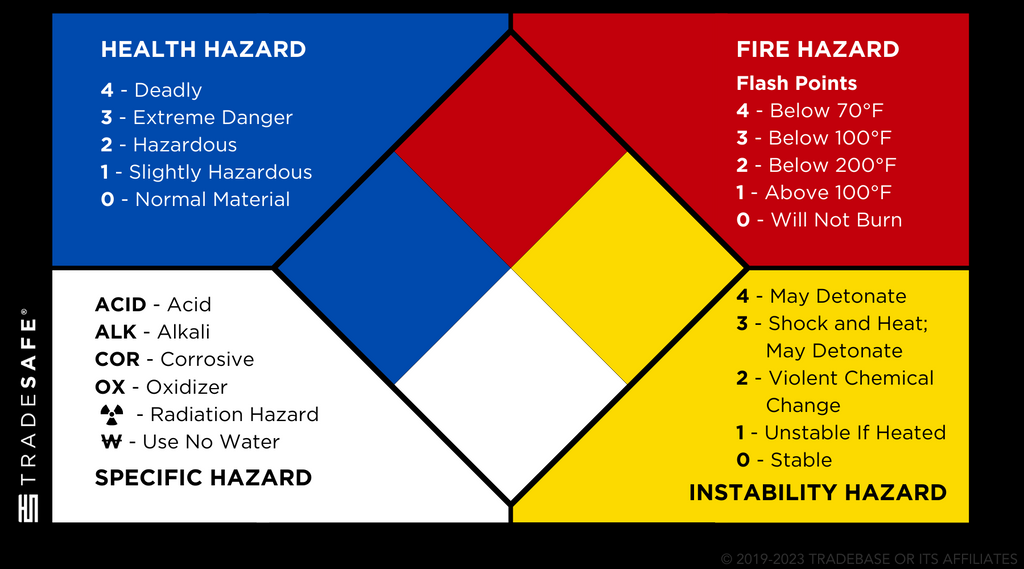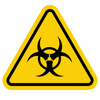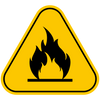
Laboratories are centers for scientific discovery and learning, but it's crucial to remember that laboratories also house a variety of potential physical and health hazards. Following proper safety protocols is essential to protect yourself, your colleagues, lab equipment, and the environment. This guide will equip you with the knowledge to maintain safety in the laboratory effectively.
Common Laboratory Hazards
Laboratories present a unique combination of potential hazards. Some of the most common include:
Fire and Explosions
Fire and explosions occur when flammable chemicals or materials, like solvents or gases, are mishandled or improperly stored. These hazards often result from open flames, chemical reactions, or electrical malfunctions. To watch out for these dangers, pay attention to how chemicals are stored and handled, and always be aware of the location of fire extinguishers and fire exits.
Inhalation and Ingestion of Toxic Chemicals
Inhalation and ingestion of toxic chemicals happen when harmful substances are accidentally breathed in or swallowed. This can occur through improper handling of chemicals, leading to spilled chemical or aerosol generation. To prevent these incidents, always place chemicals in a fume hood or use them in well-ventilated areas, wear appropriate respiratory protection, and never bring food or drinks into the lab.
Thermal and Chemical Burns
Thermal and chemical burns are caused by exposure to hot surfaces, steam, or corrosive chemicals. These burns frequently happen when safety protocols for handling hot equipment or dangerous chemicals are not followed. To mitigate these risks, wear protective gloves and clothing, and follow guidelines for handling hot materials and chemicals.
Skin Absorption of Chemicals
Skin absorption of chemicals takes place when hazardous substances come into direct contact with the skin, often due to spills or improper use of protective gear. To avoid this, always wear suitable gloves and protective clothing, and clean any spills immediately. Not only that, but It’s also imperative for laboratories to have a comprehensive chemical spill response plan in place. This plan enhances the laboratory's ability to deal with accidents effectively, minimizing the risk of skin absorption and other hazards associated with chemical spills.
Cuts to the Skin
Cuts to the skin often result from the improper use of sharp instruments like glassware or scalpels. Ensuring that these tools are handled carefully and stored correctly when not in use can prevent such injuries. Always use sharp objects with caution and wear protective gloves when necessary.
Infectious Diseases
Infectious diseases can spread in the laboratory due to exposure to biological agents like bacteria, viruses, or fungi. These hazards are prevalent in labs dealing with biological samples. To protect against infectious diseases, lab personnel use proper containment procedures, such as biological safety cabinets, and wear appropriate personal protective equipment (PPE) like safety glasses and gloves.
OSHA Requirements for Laboratories

OSHA's requirements for lab safety are specifically outlined in the OSHA standard for laboratories, 29 CFR 1910.1450, known as occupational exposure to hazardous chemicals in laboratories. This standard aims to protect laboratory workers and human health from the hazards associated with chemicals.
Key elements of the OSHA Laboratory Standard include:
- 1910.1450(e) Chemical Hygiene Plan (CHP): Laboratories are required to develop, implement, and maintain a Chemical Hygiene Plan. This plan should detail lab safety procedures for the safe handling, storage, and disposal of chemicals. The CHP must also outline measures to prevent accidents, including exposures, spills, and fires, ensuring a safe working environment for all laboratory personnel. The CHP must be readily accessible to laboratory workers and updated as necessary.
- 1910.1450(f) Employee Information and Training: The standard requires that employees are informed of the hazards associated with chemicals in their work area and are trained on the appropriate work practices, emergency procedures, and PPE to be used. Training must be conducted at the time of initial assignment and whenever a new chemical hazard is introduced.
- 1910.1450(g)(1)(ii) Exposure Monitoring and Medical Consultation: When there is evidence that exposure levels for a hazardous chemical exceed the permissible limits, monitoring must be conducted. If exposure levels are above the action level or permissible exposure limits, medical consultation must be provided to affected laboratory employees.
- 1910.1450(h) Hazard Identification: Proper labeling of chemical containers using NFPA diamond or GHS symbols, and the provision of material safety data sheets (MSDSs) for each hazardous chemical are required to inform workers of the hazards and safe handling practices.
- 1910.1450(e)(3)(ii) Use of Control Measures: Engineering controls, such as fume hoods, and personal protective equipment must be used to reduce employee exposure to hazardous chemicals.
- 1910.1450(j) Recordkeeping: Records of exposure monitoring, medical consultations, and training are to be maintained to track compliance and effectiveness of the program.
Key Lab Safety Rules and Guidelines
Know the Location of Lab Safety Equipment and How to Use It
Don't ignore the importance of knowing where laboratory safety equipment is located and how to use it. In an emergency, not knowing how to quickly and effectively use safety devices like fire extinguishers, eyewash stations, and safety showers can lead to severe consequences. Instead, take the time to familiarize yourself with all the laboratory safety equipment. Ensure you know how to operate them properly and conduct regular checks to verify they are in good working order.
Wear Appropriate Clothing and Gear
Don't wear inappropriate clothing such as open-toed shoes, shorts, or loose-fitting garments in the lab. Such attire leaves you vulnerable to spills, splashes, and other hazards that can cause injuries or contamination. Do wear protective clothing, including lab coats, safety goggles, gloves, and closed-toe shoes, to shield yourself against potential hazards and maintain a safe working environment.
Read Chemical Safety Information
Don't handle chemicals without consulting their safety data sheets (SDSs) and labels first. Misunderstanding a chemical's properties can lead to incorrect handling, which may cause accidents or exposure to harmful substances. Ensure that you read and understand the SDSs and labels before working with any chemicals. This knowledge is crucial for the safe handling, storage, and disposal of substances in the lab.
Avoid Food and Drinks in the Lab
Don't bring food or drinks into the lab or consume them there, as this can lead to contamination and accidental ingestion of hazardous chemicals. Eat and drink in designated areas away from the lab to avoid any risk of chemical exposure. Keeping food and beverages out of the lab also helps maintain a clean and safe workspace.
Treat Everything Like It’s Hazardous
Don't treat any chemical or material casually, even if you are familiar with it. Accidents often occur with substances that are underestimated in terms of their potential hazards. Treat all chemicals and materials as if they are hazardous. Use all necessary safety precautions and handle everything with care to prevent accidents and ensure a safe laboratory environment.
Don't Casually Dispose of Chemicals
The disposal of hazardous materials must be taken seriously. Don't casually dispose of chemicals by pouring them down the sink or throwing them in the regular trash, as improper disposal of hazardous materials can lead to environmental damage and health risks. Do follow your laboratory's chemical waste disposal guidelines. Use appropriate containers for hazardous waste, label them correctly, and ensure they are disposed of according to the established lab safety procedures to minimize the impact on health and the environment.
More Lab Safety Rules
- Label all chemicals and solutions clearly
- Never smell or taste chemicals
- Use fume hoods when working with volatile substances
- Regularly check and maintain laboratory safety equipment
- Store flammable and reactive chemicals in safe chemical storage containers
- Follow protocols for safe heating and cooling of substances
- Understand and practice emergency procedures
- Never work alone in the laboratory
- Ensure proper ventilation in the lab at all times
- Train new employees and students on lab safety procedures
Common Laboratory Safety Signs and Symbols

The NFPA diamond is a standard label used to indicate the risks associated with hazardous materials. Here's an explanation of each section and its meaning:
- Red (Top) - Flammability – This section assesses the material's ability to catch fire. Numbers range from 0 (will not burn) to 4 (extreme fire hazard).
- Blue (Left): Health Hazard – It indicates the level of health risk posed by the material, from 0 (no hazard) to 4 (life-threatening).
- Yellow (Right): Instability/Reactivity – This part shows the likelihood of the material to react dangerously, with 0 being stable and 4 being highly reactive.
- White (Bottom): Special Information – This area contains symbols for special hazards, like radioactivity or water reactivity.
The NFPA diamond is used in labeling chemical containers and in areas where chemicals are stored or used, providing quick and essential information about the hazards to ensure safe handling and emergency response.
Other Laboratory Safety Symbols
| Hazards | Laboratory Safety Symbols | Meaning | Usage |
| Biohazard |
 |
It indicates the presence of biological materials that pose a risk to living organisms, such as bacteria, viruses, or toxins | Used in areas where infectious agents or biological hazards are present, like in medical, clinical, or research laboratories |
| Flammable |
 |
It denotes materials that can ignite easily and pose a fire risk | This symbol is found on containers of various flammable materials, liquids, gases, or solids, and in areas where fire hazards exist |
| Corrosive |
 |
Indicates substances that can cause severe burns to skin, eyes, and materials, or damage metals | Applied to containers of acids, bases, and other corrosive chemicals |
| Toxic |
 |
Warns of substances that can cause severe harm or death if inhaled, ingested, or absorbed through the skin | Found on containers of poisonous or toxic substances |
Lab Safety Procedures: Emergency Exits and Evacuation
Emergency response planning in laboratories is crucial for ensuring safety in the laboratory of all personnel in case of an incident. This planning involves:
- Clear Marking of Exit Routes: All exit paths should be clearly marked with visible laboratory safety signs, usually in green or red, showing the direction to exit the building. TRADESAFE provides emergency exit signs made from industrial-grade, ultra-tough material. These durable signs ensure that exit routes are clearly marked and remain visible even in harsh conditions, contributing to a safer work environment.
- Unobstructed Exits: Emergency exits must always be clear of obstructions to allow quick and safe evacuation.
- Regular Drills: Conducting regular evacuation drills ensures that everyone knows how to exit the building safely and quickly during an emergency.
- Evacuation Maps: Posting evacuation maps in prominent locations helps individuals understand their nearest exits and assembly points.
- Training: Training employees on evacuation procedures, including how to assist visitors and those with disabilities during an emergency, is essential.
Laboratories must have well-defined emergency exits and evacuation procedures to manage incidents effectively and minimize harm to personnel and property.
Lab Safety FAQs
What is the most common type of lab accident?
Spills and exposure to hazardous chemicals are the most common types of lab accidents.
What are the 4 pieces of safety equipment present in each lab?
The must-have laboratory safety equipment present in each lab includes a fire extinguisher, eyewash station, safety shower, and first aid kit.
When should a lab coat, safety goggles, and gloves be worn in the laboratory?
These should be worn at all times when handling chemicals, conducting experiments, or whenever there is a potential for exposure to hazardous materials.
Where in the laboratory is long, unrestrained hair most likely to be a safety concern?
Near open flames, such as Bunsen burners, or moving machinery where it can get caught, posing a fire or mechanical hazard.
What should you do after finishing work with a reagent bottle?
Close the bottle tightly, label it if necessary, and return it to its designated storage area to prevent spills and contamination.
